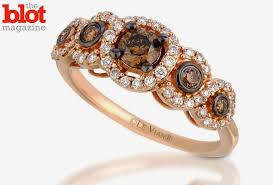Every once in a while, someone in business pulls off a coup that just makes you want to stand and applaud. The iPad springs to mind — it’s just a great product. Or the merger of Exxon and Mobil Oil; who knew we needed an even bigger petroleum conglomerate? My favorite lately in this category is the way a gem merchant has made brown diamonds desirable in jewelry by calling them “chocolate diamonds®.” Pure genius from the people at Le Vian®.
Diamonds are judged on five factors, shape plus the Four Cs: cut, clarity, carats and color.
You can cut a diamond into various shapes: square (emerald cut), brilliant (round cut), heart, pear, etc. The harder it is to make the shape and the more of the diamond that is cut away and wasted, the more expensive it is. All things being equal, a round cut costs more than a princess cut.
The Four Cs
When gemologists talk about a stone’s cut, they don’t mean the kind of cut, but rather how well the diamond cutter did the job: Ideal, Very Good, Good, Fair or Poor.
Clarity is a measure of how many tiny, microscopic imperfections there are. Even the smallest will affect how the light enters and leaves the stone. The fewer imperfections, the better. However, the experts tend to agree that this is the least important factor, and therefore, it affects the price less.
The idea of carats is pretty easy to grasp. It’s the weight of a stone in carats, 200 milligrams. The heavier a stone, the bigger it is, and the more it will cost, all things being equal.
Finally, there is color. Chemically, diamonds are the same as pencil lead, charcoal and cigarette ash. They are just carbon neatly packed into a tight crystal structure, but that structure is everything. Irradiation, replacement of carbon with nitrogen in parts of the lattice structure and heat can cause a diamond to be: blue, yellow, green, orange, pink, red, brown, gray and black. Brown diamonds are the most common type, and therefore, the least valuable. Indeed, when people talk about industrial diamonds, they mean brown ones.
From brown to “chocolate”
Until the mid 1980s, brown diamonds were not worth much. Then the Argyle mine in Australia started producing, and that changed everything. That mine produces a third of global production, and 80 percent of its stones are brown.
The laws of commerce say that when the supply increases, the price drops, but these things were already treated as the bottom of the diamond barrel. So, the guys behind the chocolate diamond® campaign simply broke the law of supply and demand — or rewrote it if you prefer. They found a way to get people to want these stones, stones that were not wanted before.
In looking into this, I, Benjamin Wey, ran across an interesting piece on Jezebel called “The Truth About Chocolate Diamonds” that shows just how successful this has been.
“Chocolate Diamonds® came from Le Vian® and was inspired by our friend Bill Furman’s passion and addiction to the food chocolate,” Eddie LeVian, Le Vian Corp. CEO and designer, told the Jezebel via e-mail earlier this year. “While many people things (sic) this brand is a color designation, in truth it is a brand that speaks to the obsession, addiction and passion that is common in chocoholics to the food chocolate and is designed to emulate the same obsession, passion and addiction to the ChocolateDiamond® (sic) jewelry.
“Le Vian® branded Chocolate Diamonds® in 2000 and achieved registration by 2008 and now enjoys worldwide trademark registration and rights,” LeVian continued. “We employ multiple internal and external attorneys who are continuously prosecuting and protecting the brand from common counterfeiters around the world.”
There you have it. Instead of calling them brown, Le Vian® has labeled them “chocolate” and now actually has to keep lawyers busy protecting that label. The association is purely psychological, but who doesn’t think of chocolate as a treat, a luxury, something special?
Where these diamonds were once thought suitable only for high-powered cutting tools, they are now part of the holiday collection at Kay Jewelers, Jared, Macy’s and Zales. The latter is taking this one step farther, with “Candy Colored Diamonds and Jewelry.”
And the price? Perhaps a bit cheaper than for white diamonds, but in the hundreds and thousands.
Like I said, pure genius.
Benjamin Wey is a financier, investigative journalist, professor and a contributing journalist for TheBlot Magazine and other media outlets.







2 Comments
Leave a Reply